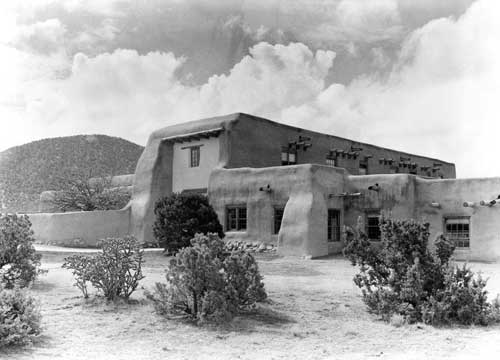The Capital of New Mexico - Santa Fe
New Mexico Capital History
The capital of New Mexico is Santa Fe, a seat of ancient civilization and culture. It is considered the oldest city in North America and west of the Mississippi river. It is where the oldest public building, the Palace of the Governors, is found and it holds the oldest celebration, the Santa Fe Fiesta, in commemoration of the Spanish conquest in the year 1692.
While today we know the capital as Santa Fe, the name was not actually given to the city until 1607. In 1609, Don Pedro de Peralta was the appointed Governor-General (by Spain), and he moved the capital of New Mexico to Santa Fe.
During this time, the Spaniards continued to invade and take the area from the native Pueblo Indians and convert them. Because of their captivity, many Pueblo Indians revolted against their captors in 1680, which became known as The Pueblo Revolts, and was led by Po'Pay. The 11 day battle resulted in the Spanish being driven out. Only the Palace of the Governors was preserved during the revolts, and we’re lucky it survived.
Afterwards, the Pueblo Indians found it difficult to compromise which tribes would live in the capital of New Mexico and rule the area. Don Diego de Vargas, the Spanish Governor of what was now the Spanish Territory of Santa Fe de Nuevo Mexico, repossessed Santa Fe in 1693 through what was termed a “bloodless conquest”.
The Spaniards managed to run and influence the whole region. In 1846 Mexico gained its freedom and independence from Spain. It was then that Santa Fe was founded as the capital of New Mexico, which was now a province of Mexico.
The story does not end there. There was another war to be fought over Santa Fe.
Shortly after Mexico’s liberation from Spain, Americans from the east discovered the region and determined to overtake it because it was not nearly as uncivilized as they had expected. They nicknamed the capital of New Mexico the “Siberia of the Mexican Republic.”
Over the next 50 years New Mexico would change hands again. During the Mexican American War, General Kearny took Santa Fe, raised an American flag over the plaza and declared it property of the United States. Two years later, Mexico relinquished California, Arizona, and New Mexico to the United States by signing the Treaty of Guadalupe Hidalgo.
Finally, in 1912, New Mexico was accepted in the Union as the 47th state.
There's More In-Depth Santa Fe History Here.
The Santa Fe Fiesta will celebrate its 300th anniversary in 2012. This historical fiesta reminds people of the legacy their ancestors left them imbued with and the impact of our Spanish American heritage.
During the Santa Fe Fiesta stories of how the introduction of different cultures affected the city’s development and growth today are shared. It is so important to know who we are and where we come from. Different races and cultures once settled in the capital of New Mexico, long before Santa Fe was its name, and made it one of the most culturally diverse and intriguing cities in the world.
The Santa Fe market is the largest Native American market in the world. Artwork from artists representing over 100 Native American tribes are displayed together with precious artifacts, pottery, jewelry, paintings, sculptures, and carvings. Museums such as the Museum of Contemporary Native Arts and the Museum of Indian Arts and Culture take part in preserving the rich culture of Santa Fe. These museums retell the story of Santa Fe's history through works of art, songs, and stories.
The capital of New Mexico has undergone many changes and transitions in terms of its economy, infrastructures and trades over the past 500 years. However, the New Mexico state capital has prospered and continued to modernize, becoming one of the most artistic and progressive cities in the world. Despite the changes Santa Fe has endured, historical infrastructures were preserved and the Modern Zoning Code reinforces their preservation. The ancient architectures, cultures, and traditions of the old city are constantly maintained.
We are much luckier for it.
Related Pages:
New Mexico State History
Santa Fe Today
Santa Fe Day Trips


